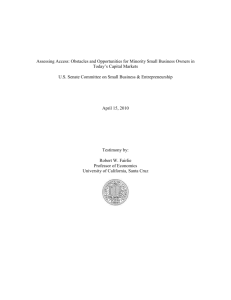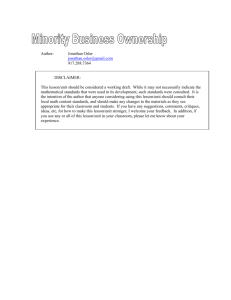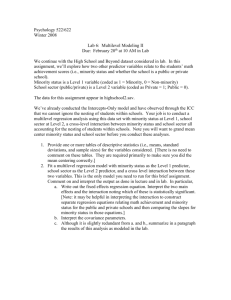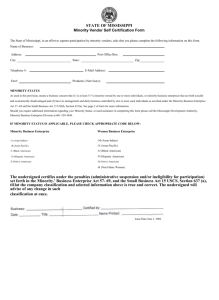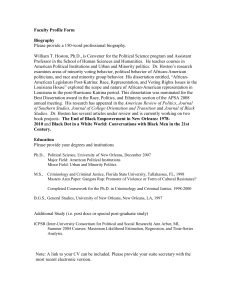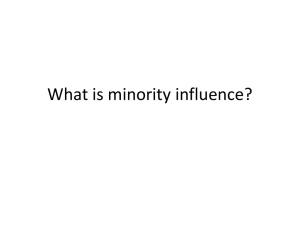Assessing Access: Obstacles and Opportunities for Minority Small
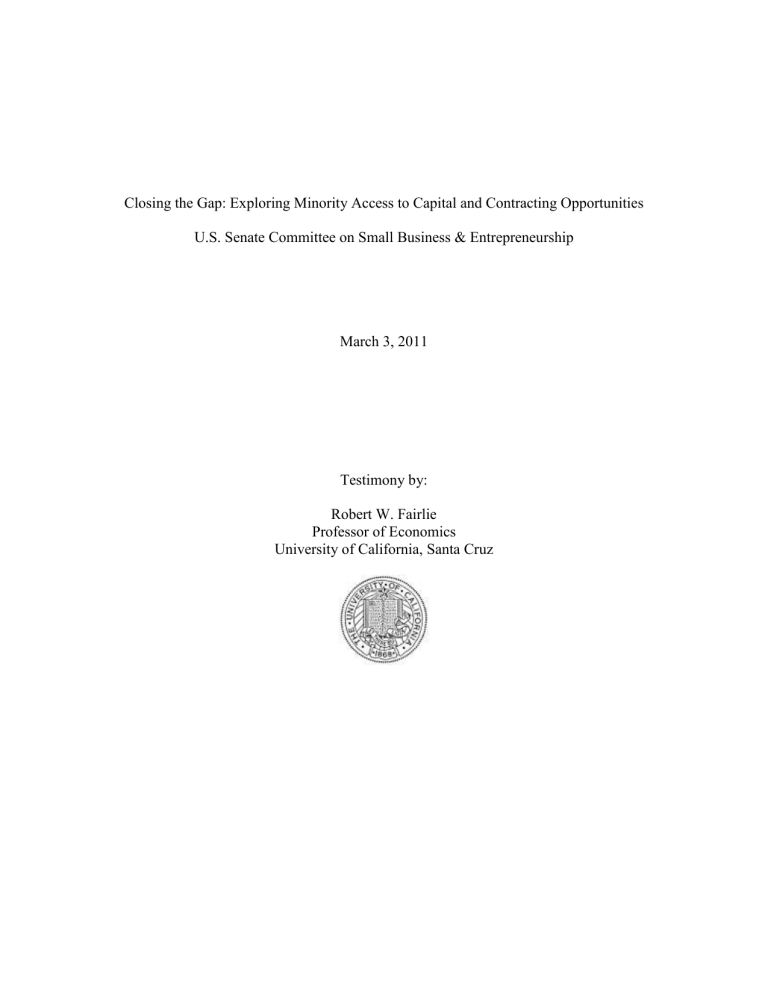
Closing the Gap: Exploring Minority Access to Capital and Contracting Opportunities
U.S. Senate Committee on Small Business & Entrepreneurship
March 3, 2011
Testimony by:
Robert W. Fairlie
Professor of Economics
University of California, Santa Cruz
Thank you, Chair Landrieu, Ranking member Snowe, and members of the Committee. It is an honor to testify before you on the important topic of wealth inequality and access to capital for minority businesses. I am a Professor of Economics at the University of
California, Santa Cruz and have studied small businesses and entrepreneurs for almost 20 years. I have been asked to briefly discuss the findings from my research on the topic.
1
The Lingering Effects of the Great Recession
The Great Recession ended in December 2009 – more than a year ago. But, the national unemployment rate remains above 9 percent. Fourteen million people are still looking for jobs and a record number have been jobless for more than a year. Although many people have turned to self-employment in face of limited employment opportunities, it is not an easy time to start a business.
Small businesses are continuing to be hit hard by the sluggish economy. The rate of businesses filing for bankruptcies in the United States is more than twice as high as it was in mid 2007. Contributing to the high rate of business closings are the lingering tight credit conditions for small businesses resulting from the financial crisis. Housing prices have also not rebounded from the beginning of the recession which is important because home equity is often used to finance business starts.
Minority-owned businesses are being hit especially hard in the current economy.
Research that I and others have conducted indicates that minority businesses face significant barriers to entry, growth and survival even in more favorable economic conditions. Minority firms are more vulnerable because they are generally smaller and have fewer resources to draw on in difficult economic times. The average minorityowned business has revenues of $178,000 per year, which is less than 40 percent of the level for non-minority businesses. Minority owned firms also hire fewer employees and have lower profit levels.
Access to Capital among Minority-Owned Businesses
One of the most important factors responsible for these disparities in business performance is access to financial capital. A large body of research shows that limited access to capital hinders the formation and growth of minority-owned businesses.
Minority-owned businesses have substantially lower levels of financial capital invested in their businesses. Figure 1 displays estimates from Federal Reserve data indicating that minority firms have much lower levels of equity investments and loan amounts than nonminority firms.
1 For more information see Robert Fairlie and Alicia Robb, Race and Entrepreneurial Success:
Black-, Asian-, and White-Owned Businesses in the United States Cambridge: MIT Press (2008).
Robert Fairlie and Alicia Robb, Disparities in Capital Access between Minority and Non-
Minority-Owned Businesses: The Troubling Reality of Capital Limitations Faced by MBEs.
, U.S.
Department of Commerce, Minority Business Development Agency, January 2010.
Figure 1: Average Equity Investments and Loan Sizes
Federal Reserve, Survey of Small Business Finances, 2003
$120,000
$100,000
$80,000
$60,000
$40,000
$108,912
$46,514
Non-Minority
Minority
$20,000
$7,822
$3,379
$0
Mean Value: Equity Investments Mean Value: Loans
Minority-owned businesses have an average of $3,400 of equity investments and $46,500 in loans. Non-minority owned businesses have values of equity investments and loans that are more than twice as large. These disparities do not disappear even after controlling for owner and firm characteristics, and have been found in several other data sources.
Wealth Inequality
One of the major causes of the lack of access to capital is the shockingly high level of wealth inequality found in the United States. The disparity in wealth between minorities and non-minorities is an order of magnitude larger than the disparity in income, for example. Estimates of median net worth from the Census Bureau are displayed in Figure
2.
Figure 2: Median Household Wealth (Net Worth)
U.S. Census Bureau
$125,000
$113,822
$100,000
$75,000
$50,000
Non-Minority
African-American
Latino
$25,000
$13,375
$8,650
$0
Median Net Worth (2004)
Half of all African-American families have less than $8,700 in total wealth, and half of all Latino families have less than $13,400. These levels of wealth are one-ninth to onethirteenth the levels of wealth held by non-minorities ($113,800).
These low levels of wealth among minorities translate into fewer startups and undercapitalized businesses because an entrepreneur's wealth is often invested directly in the business or used as collateral to obtain business loans. Entrepreneurs are also
2
frequently required by investors to invest their own money in the business as an incentive.
Contributing to the patterns in wealth inequality are low rates of minority home ownership and lower levels of home equity. Estimates of home ownership from the
Census Bureau are displayed in Figure 3. Less than half of African-American and Latino families own their own homes compared with roughly three-quarters of non-minority families.
Figure 3: Home Ownership and Unbanked Rate
U.S. Census Bureau, Bureau of Labor Statisics and FDIC
80%
74.4%
70%
60%
50%
40%
30%
20%
45.4%
47.5%
21.7%
19.3%
Non-Minority
African-American
Latino
10%
3.3%
0%
Home Ownership (2010) Unbanked (2009)
Figure 3 also displays recent estimates from a joint study by the Census Bureau, BLS and
FDIC on unbanked rates. As both a symptom and cause of wealth inequality many minority families do not have a savings or checking account. More than 20 percent of
African-American families and just under 20 percent of Latino families do not have a bank account. The same data indicate that minorities are more likely to use higher-cost financial services such as payday loans.
Lending Discrimination
Further limiting the ability of minority entrepreneurs to obtain financial capital is racial discrimination in lending practices. Several studies have examined whether minority firms face discrimination in obtaining business loans.
2 The main finding from this
2 David G. Blanchflower, P. Levine, and D. Zimmerman, "Discrimination in the Small Business
Credit Market," Review of Economics and Statistics 85, no. 4 (2003): 930-943. Ken Cavalluzzo,
Linda Cavalluzzo, and John Wolken. “Competition, Small Business Financing, and
Discrimination: Evidence from a New Survey,” Journal of Business 75, no. 4 (2002): 641-679.
Ken Cavalluzzo and John Wolken, "Small Business Loan Turndowns, Personal Wealth and
Discrimination," Journal of Business 78, no. 6 (2005): 2153-2177. Lloyd Blanchard, John Yinger and Bo Zhao, "Do Credit Market Barriers Exist for Minority and Women Entrepreneurs?"
Syracuse University Working Paper (2004). Susan Coleman, "The Borrowing Experience of
Black and Hispanic-Owned Small Firms: Evidence from the 1998 Survey of Small Business
Finances," The Academy of Entrepreneurship Journal 8, no. 1 (2002): 1-20. Susan Coleman,
"Borrowing Patterns for Small Firms: A Comparison by Race and Ethnicity." The Journal of
Entrepreneurial Finance & Business Ventures 7, no. 3 (2003): 87-108. K. Mitchell and D.K.
3
literature is that minority-owned businesses are more likely to experience loan denials, pay higher interest rates, and are less likely to apply for loans because of a fear of rejection. Figure 4 reports estimates from an analysis that I conducted with Federal
Reserve data.
Figure 4: Loan Denial, Fear of Applying for Loans, and Interest Rates
Federal Reserve, Survey of Small Business Finances, 2003
35.0%
31.5%
29.5%
30.0%
25.0%
20.0%
15.0%
15.8%
Non-Minority
Minority
12.3%
10.0%
5.0%
6.4%
7.8%
0.0%
Denial Rate Did not Apply: Fear of Rejection Interest Rate
These data show that minority firms are twice as likely to be denied a loan application and are twice as likely to not apply for a loan because of a fear of rejection. Minority firms that do obtain loans pay one and a half percentage points higher interest rates on those loans than non-minority firms. These disparities do not disappear even after controlling for the age, experience and education of the owner, and the creditworthiness, size, industry, age and location of the firm, which is consistent with the existence of lending discrimination.
The Potential of Minority-Owned Businesses
Minority-owned businesses make enormous contributions to the U.S. economy.
Businesses owned by minorities produce more than $1 trillion in total sales. They employ
6 million workers and have an annual payroll of $168 billion. They also create another 6 million jobs for themselves as owners.
In closing, although minority-owned businesses contribute greatly to the economy, there remains a lot of untapped potential among this group of firms. As I have discussed, minority entrepreneurs face substantial barriers to obtaining financial capital. These barriers include low levels of wealth, home ownership and banking, and lending discrimination. Restricting minority business growth ultimately limits total U.S. productivity, job creation and innovation, which are essential for getting our economy back on track.
Pearce, Availability of Financing to Small Firms using the Survey of Small Business Finances ,
U.S. Small Business Administration, Office of Advocacy (2005). R. Bostic and K.P. Lampani,
“Racial Differences in Patterns of Small Business Finance: The Importance of Local Geography,”
Working Paper (1999).
4
Thank you for the opportunity to present the findings from my research on this topic. I look forward to hearing your comments and questions.
5
